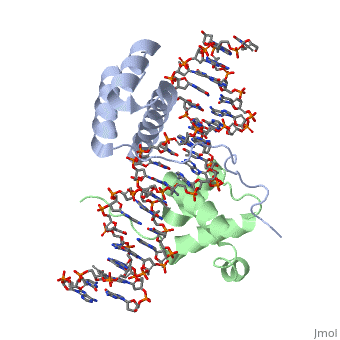Tyrone Evans Hox Proteins sandbox
From Proteopedia
(Difference between revisions)
| Line 13: | Line 13: | ||
Hox genes, which hold the instructions for how each protein should be constructed, are regulated by both gap genes and pair-rule genes. Gap genes are responsible for the development of particular sections of an organism, more specifically for embryos of some arthropods. If a mutation occurs with these genes, adjoining body sections can be loss. Pair-rule genes are similar to gap genes but instead of being involved in the development of arthropods, it participates in the segment development of insects. And both of these regulators are ultimately regulated by maternally-supplied mRNA. In a series of events, depending on the amount of said maternally-supplied mRNA either the gap or pair-rule genes are activated, which in turn activate the Hox genes, allowing them to cause a differentiation in the genes that are responsible for the construction of proteins for embryo development. | Hox genes, which hold the instructions for how each protein should be constructed, are regulated by both gap genes and pair-rule genes. Gap genes are responsible for the development of particular sections of an organism, more specifically for embryos of some arthropods. If a mutation occurs with these genes, adjoining body sections can be loss. Pair-rule genes are similar to gap genes but instead of being involved in the development of arthropods, it participates in the segment development of insects. And both of these regulators are ultimately regulated by maternally-supplied mRNA. In a series of events, depending on the amount of said maternally-supplied mRNA either the gap or pair-rule genes are activated, which in turn activate the Hox genes, allowing them to cause a differentiation in the genes that are responsible for the construction of proteins for embryo development. | ||
| - | While these Hox proteins can be regulated, they also do a fair amount of regulation that consist of major networks of other genes like those who are responsible for limb formation. Examples of genes that are regulated by Hox proteins in both Drosophila and Mice. | ||
== Interaction with DNA == | == Interaction with DNA == | ||
| Line 48: | Line 47: | ||
== References == | == References == | ||
<references/> | <references/> | ||
| - | Berman, Helen M., John Westbrook, Zukang Feng, Gary Gilliland, T. N. Bhat, Helge Weissig, Ilya N. Shindyalov, and Philip E. Bourne. "The Protein Data Bank." RCSB. Nucl. Acids Res. (2000) 28 (1): 235-242 Web. | + | <ref>Berman, Helen M., John Westbrook, Zukang Feng, Gary Gilliland, T. N. Bhat, Helge Weissig, Ilya N. Shindyalov, and Philip E. Bourne. "The Protein Data Bank." RCSB. Nucl. Acids Res. (2000) 28 (1): 235-242 Web.</ref> |
| - | "Hox Gene." Wikipedia. Wikimedia Foundation, 14 Aug. 2015. Web. 20 Oct. 2015. | + | <ref>"Hox Gene." Wikipedia. Wikimedia Foundation, 14 Aug. 2015. Web. 20 Oct. 2015.</ref> |
| - | Freeman, Quillin, and Allison. Biological Science. 5th ed. Vol. 1. N.p.: Benjamin Cummings, n.d. Print. | + | <ref>Freeman, Quillin, and Allison. Biological Science. 5th ed. Vol. 1. N.p.: Benjamin Cummings, n.d. Print. |
| + | </ref> | ||
Revision as of 16:41, 3 November 2015
Hox Proteins
| |||||||||||

